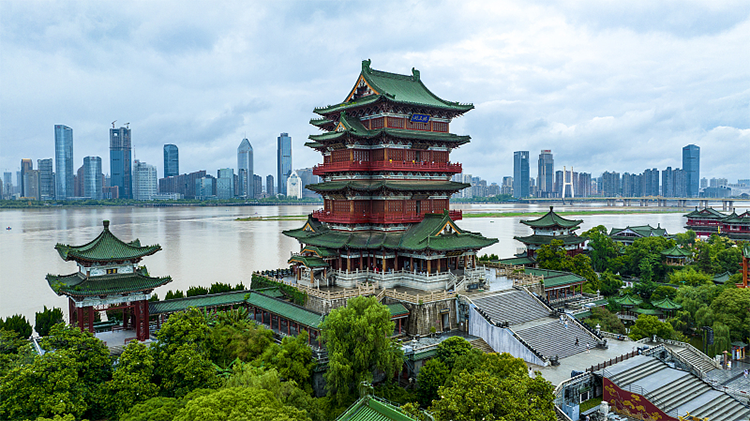Tengwang Pavilion: A Tang Dynasty Architecture Masterpiece in Nanchang
Introduction:
Standing on the banks of the Gan River and looking up at the vermilion pavilion with its sweeping eaves, you can almost step back into the Tang dynasty. Tengwang Pavilion is not only a Nanchang landmark but a frozen poem—Wang Bo’s famous lines “the rosy clouds fly with the lone wild goose; autumn waters and the sky are one color” find an eternal home here. Once a preferred site for scholars to ascend and compose, the pavilion still carries the grandeur of Jiangnan and echoes of history. From the top you’ll see the Gan River ribboning through the city, where modern life and ancient charm meet—inviting a slow, literary journey through time.
1. Soul Summary: A Living Epic of Jiangnan’s Famous Pavilion
“One pavilion, half a Tang poem.” Tengwang Pavilion rose to worldwide fame through Wang Bo’s renowned prose-poem Tengwang Ge Xu and is considered the most literary of the “Three Great Pavilions of Jiangnan.” More than an architectural icon, it’s a living museum of literature—every tile and brick scented with ink and memory.
2. A Millennium of History: From Prince Teng’s Gatherings to a Scholars’ Sanctuary
– Origin in splendor: In 653 CE, Li Yuanying (Prince Teng), brother of Emperor Taizong, commissioned the original pavilion as an entertainment and banquet hall. Wang Bo’s impromptu composition in 675 transformed the site into a cultural shrine.
– Reborn through fire and time: After 28 reconstructions and destructions, the present pavilion was rebuilt in 1989 following Song dynasty building codes (Yingzao Fashi). The nine-story, 57.5-meter structure captures the lofty, layered grandeur once described as “rising through the clouds.”
– A cultural IP across eras: Poets such as Su Shi and Xin Qiji left verses here; steles and restoration records inside link visitors to the rise and fall of Chinese tower architecture.

3. Architectural Aesthetics: The Craft of a Song-style Tower
– Flying eaves and bracket sets: The pavilion’s three-tiered verandas follow a Ming-three-dark-seven rhythm, with turquoise glazed tiles and vermilion columns. Bronze bells at the eaves chime in the wind, expressing the restrained elegance of official Song architecture.
– Beauty in the details: Look up to see the flowing curves of the nine-ridged hip-and-gable roof and the painted beam panels illustrating “Tengwang Pavilion Banquet,” recreating Tang court entertainment.
– Best viewpoints: The fifth-level observation deck frames the Gan River against the city skyline—arrive before sunset to secure a spot for the classic “rosy clouds and lone goose” composition.
4. Immersive Experiences: When Ancient Poetry Meets Modern Tech
– Poetry interaction: In the digital exhibition hall you can try calligraphy copies of Tengwang Ge Xu; AR effects turn brush strokes into flocks of birds across the sky. Nightly projections display Wang Bo’s lines across the pavilion façade.
– Cultural gatherings: During spring and autumn the pavilion hosts “Tang Poetry Salons.” Visitors can wear hanfu, join traditional verse games, or listen to professional recitals accompanied by guqin.
– Hidden finds: Hunt for the pavilion’s treasure—a Qing-era cloisonné enamel model of Tengwang Pavilion—whose miniature doors and window patterns are astonishingly precise.

5. Nearby Connections: A One-Day Gan River Cultural Route
– Morning: After sunrise from the pavilion, walk 10 minutes to Tengwang Pavilion Pier and take a river cruise that links Bayi Bridge and Qiushui Square. Boats serve a “Tengwang tea and snacks” set.
– Afternoon: Visit the nearby Jiangxi Provincial Museum (free entry) where Han treasures from the Haihunhou tomb resonate with the pavilion’s artifacts.
– Evening: Stroll the Gan River promenade to the “Nanchang Star” Ferris wheel—at 160 meters you’ll see the illuminated pavilion below, a perfect interplay of old and new.
6. Practical Guide
– Opening hours: 08:00–18:00 (extended to 19:00 during summer solstice). Night light shows on Fridays and Saturdays, 19:30–21:00.
– Tickets: Main pavilion 50 CNY including elevator access. Consider upgrading to the live show “Dreaming Tengwang Pavilion” (268 CNY), which follows a narrative of Wang Bo’s imagined return.
– Getting there: Metro Line 1 to Wanshougong Station, 15-minute walk; taxis to “Tengwang Pavilion East Gate” are more direct. Limited nearby parking—public transport recommended.
– Beat the crowds: Avoid National Day and Chinese New Year. Weekdays before 10:00 are quieter; mid-level stair windows on floors three and four form natural picture frames without the summit crowds.

Conclusion:
When the setting sun gilds the pavilion and the river breeze sets the eave bells ringing, you’ll understand how Wang Bo felt: a sudden lifting of the chest and a flight of fancy. Here architecture is poetry, the landscape is verse, and even the flow of time seems to follow an ancient rhythm. Whether you’ve read the classic prose-poem or not, Tengwang Pavilion will inscribe an unforgettable chapter in your China travels.


